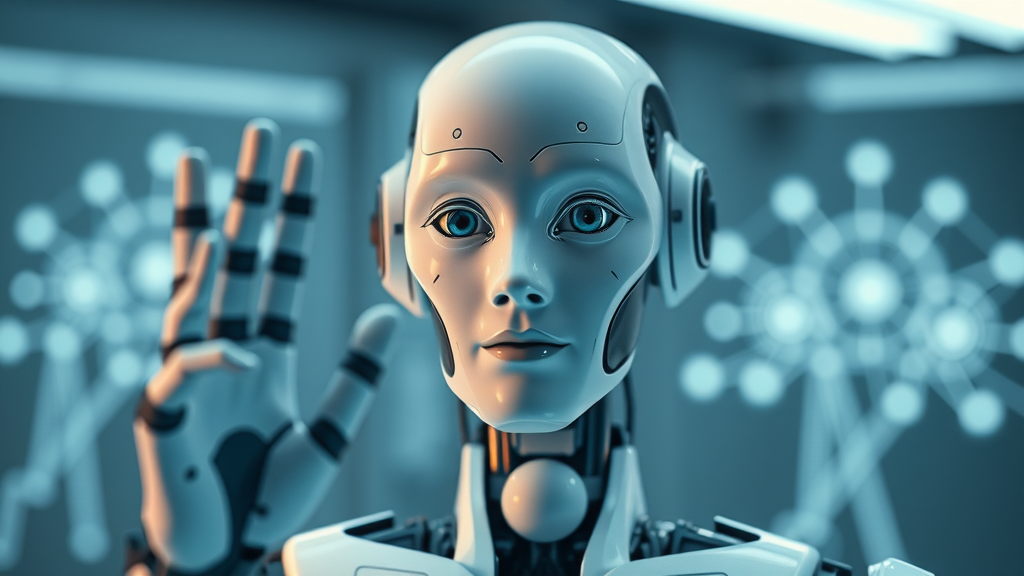Did you know? By 2030, up to 70% of businesses could leverage autonomous artificial intelligence, redefining competitive advantage in local markets. Autonomous AI isn’t just for tech giants—it’s transforming neighborhood cafés, boutiques, and service companies in ways that were unimaginable only a few years ago. If you’re a local business owner, this guide will open your eyes to powerful yet practical ways autonomous AI can deliver marketing superpowers to your team.
Startling Growth: How Autonomous Artificial Intelligence Is Revolutionising Local Business
Autonomous artificial intelligence is driving incredible changes for small- and medium-sized businesses. Unlike older AI models that require heavy human guidance, these new autonomous systems act more like smart helpers or even team members, completing complex tasks with little need for step-by-step instruction. Across the globe, local businesses are seeing boosts in sales, customer loyalty, and staff productivity, all thanks to these next-level AI agents.
"By 2030, up to 70% of businesses could leverage autonomous artificial intelligence, redefining competitive advantage in local markets." – Industry Analyst
- Autonomous AI can run email marketing and social campaigns 24/7—no coffee breaks required
- Local businesses using AI agents have seen up to 40% faster customer response times
- AI-driven personalisation drives an average 20% uplift in customer retention for SMEs
- Predictive AI inventory systems prevent costly stockouts with real-time recommendations

What You'll Learn About Autonomous Artificial Intelligence
- Core concepts of autonomous AI systems
- Key differences compared to traditional AI agents
- Practical marketing applications for local businesses
- Real-world case studies
- Implementation tips and best practices
Understanding Autonomous Artificial Intelligence
For most local business owners, the term autonomous artificial intelligence might sound overwhelming or futuristic. In reality, it’s about giving AI agents the ability to think for themselves—learning, adapting, and handling routine marketing and operational tasks on your behalf. These advanced AI systems can work across a wide range of business functions, making decisions and solving problems without human intervention.
Defining Autonomous Artificial Intelligence

Autonomous artificial intelligence refers to AI systems or agents capable of performing specific tasks, improving results over time, and making smart choices—all without being told exactly what to do each step of the way. Imagine an AI agent handling your social media: it not only posts at the best times, but learns which posts get the most engagement and then automatically adjusts future campaigns for you. These autonomous systems go far beyond traditional AI by combining machine learning, deep learning, and smart reasoning within a single, flexible framework, making them ideal partners for small marketing teams.
How Autonomous AI Differs From Traditional AI Agents and AI Systems
Unlike basic or “reactive” AI models that require detailed, frequent guidance, autonomous AI is self-directed. While a classic AI agent might produce a single ad copy based on your input, an autonomous system can draft, test, and adjust multiple ads across platforms—all on its own. It uses feedback from real results (like clicks or sales) to get better with every campaign. This major step up in capability lets small businesses tackle complex tasks like predictive analytics, automated content generation, and even inventory management with minimal oversight. The secret? Integrating large language models and agentic ai frameworks to break free of old limits.
Key Features of Autonomous AI Agents and Systems
Modern autonomous systems are more than just rules-based bots. Key features include:
- Self-Learning: These AI agents improve over time based on data and experience.
- Autonomous Decision-Making: They act and adapt without needing constant human checks.
- Context Awareness: They can understand changing business needs and customer behaviors.
- Continuous Operation: Autonomous AI works 24/7, supporting marketing, sales, and support teams even after hours.
The Role of Language Models and Large Language Models in Autonomous AI

At the core of many autonomous AI systems are powerful language models and large language models (LLMs). These tools process natural language, generate human-like responses, and even automate tasks like messaging, content creation, or support. For marketers, a language model can instantly create ad copy, compose emails, or provide answers to customer questions. Generative AI—powered by language models—enables these systems to “think ahead,” offering fresh content or solutions without repeating old patterns. With these AI tools, small teams can achieve results that normally require an entire marketing department.
How Generative AI Powers Autonomous Solutions
Generative AI is central to autonomous artificial intelligence. By using extensive data sets and deep learning, generative AI models continually create new text, images, and solutions to marketing challenges. For example, if you run a local shop, these systems can recommend personalized promotions for every customer based on their unique purchase history. They can also experiment with new campaign ideas and adjust strategies in real-time for better engagement—taking a heavy load off your busy team, while keeping marketing campaigns fresh, targeted, and effective.
Critical Benefits: Why Local Businesses Can't Ignore Autonomous Artificial Intelligence
- Increased efficiency
- Cost reduction
- Enhanced decision-making
- Continuous learning and adaptation
Autonomous AI delivers clear, measurable advantages for local enterprises. By automating complex tasks, these systems reduce costs, boost marketing return on investment, and free up your best people for important face-to-face moments with customers. Efficient AI agents can quickly analyze trends, predict what’s coming next, and recommend fresh approaches tailored to your local audience—all while running in the background so you can focus on growth.
Empowering Small Teams with Autonomous AI Agents
"AI agents can automate 75% of marketing tasks for small businesses, redirecting precious time to customer engagement and strategy." – Marketing Expert

Autonomous AI is a true game-changer, especially for businesses where every team member wears many hats. AI agents can manage social media posting, reply to customer messages, automate ad spending, and even keep your inventory up to date. This 24/7 support means your team can focus on face-to-face work, strategic planning, and building customer loyalty—while the AI handles tasks behind the scenes.
Standout Examples: Autonomous Systems Already Transforming Local Enterprises
- Automated local SEO support
- Personalised customer messaging via language models
- Predictive analytics with generative AI
- Inventory management with complex autonomous systems
Many local businesses are already seeing results with autonomous AI. Bakeries use chatbots built on large language models to answer customer questions instantly. Dentists schedule appointments automatically with agentic AI. Shops use predictive analytics to understand which products might sell out soon, so stock can be reordered with zero effort. This is the new reality where the right AI model not only supports but actively improves business operations every single day.
How Autonomous Artificial Intelligence Works: Technology Breakdown
The Autonomous AI Agent Hierarchy

Think of autonomous AI agents as part of a well-organised hierarchy. At the bottom are simple bots handling individual, repetitive tasks. Higher up are advanced agents that handle decision-making—like optimizing your ad budget or scheduling marketing emails. At the top, there are agentic AI systems that manage and coordinate these AI agents for even more complex tasks (like running multi-channel campaigns that adapt to your real-time sales data).
Agentic AI: Orchestrating Multiple Autonomous Systems
Agentic AI platforms coordinate a whole network of ai agents. Think of this like an orchestra: each agent plays one “instrument,” but the agentic AI ensures they’re all in harmony, working towards your business goals. These platforms make it possible for even the smallest shops to use a combination of AI-driven tools—content creation, customer follow-ups, and ad management—without needing to micromanage each one.
From Data Input to Action: The Language Model Workflow

Autonomous AI systems start with raw data: customer preferences, campaign results, or product inventories. This data flows into large language models and generative AI engines that analyze, interpret, and recommend actions. The system then automatically creates content, suggests social posts, or makes inventory decisions. All of this happens without human intervention, but you can still jump in to fine-tune the process if needed. This seamless loop keeps your marketing agile, data-driven, and responsive.
Integrating Large Language Models with Generative AI for Hyperlocal Results
Combining large language models with generative AI gives you powerfully accurate and context-aware solutions. For local businesses, this means hyper-personalized messages based on local trends, real-time feedback, and customer buying habits. For example, a bakery’s AI system might analyze the weather forecast and suggest a campaign for hot drinks on a cold day, knowing that’s when locals will most appreciate it. This “human-like” awareness can take small teams’ marketing impact to the next level.
How AI Agents Execute Multi-Step Processes Without Human Intervention
One of the biggest perks of autonomous artificial intelligence is autonomy itself. AI agents can go far beyond just “if this, then that.” They break complicated tasks into logical steps, then learn which approach works best through trial and error. Whether running a multi-week Google Ads campaign or adjusting staffing schedules based on busy times, AI systems can execute, learn, and optimize—no manual checklists or reminders required from you.
| Feature | Autonomous AI System | Traditional AI |
|---|---|---|
| Level of Autonomy | High—Self-directed operation | Low—Requires frequent input |
| Learning Capability | Continuous, adaptive | Limited, rules-based |
| Decision Making | Dynamic, data-driven | Preset, fixed rules |
| Example Tasks | Full campaign management, personalisation, predictive analytics | Single-task execution (e.g., scheduling) |
Real-World Case Studies: Autonomous Artificial Intelligence in Local Marketing

Let’s explore some true stories of how local businesses harness autonomous AI to win big in their communities. These case studies highlight practical marketing uses—real results, not just hype.
Optimising Social Media Campaigns Using AI Agents

A local café owner wanted to grow their Instagram and Facebook following—but their two-person team was stretched thin. After adopting autonomous AI agents, the business saw instant results: the AI recommended ideal posting times, tested different content themes, adjusted based on real engagement, and even responded to customer comments automatically. Engagement soared, freeing staff to focus on in-store hospitality while AI took care of online growth.
Personalisation Engines: Leveraging Generative AI for Customer Loyalty
A boutique clothing shop used to send the same email campaign to every customer. By integrating a generative AI-driven personalisation engine, they enabled emails tailored to individual style preferences and purchase history. The system continuously learned and adapted, sending offers and suggestions that truly resonated—with open rates and repeat visits climbing each month. This is how autonomous artificial intelligence builds relationships and lasting loyalty on auto-pilot.
Local SEO and Content Generation Services Powered by Autonomous Systems
A neighborhood gym struggled to keep up with blog posts and SEO tasks. They invested in an agentic AI platform, which used large language models to produce fresh web content optimized for the latest search terms. It also adjusted class schedules and promotions in response to membership trends. As a result, the gym’s website ranked higher locally, and foot traffic picked up—proof that autonomous systems, when set up smartly, quickly pay for themselves.
Five Immediate Steps to Get Started with Autonomous Artificial Intelligence
- Identify marketing pain-points suitable for automation
- Evaluate available autonomous AI agents and systems
- Test language models for content tasks
- Set KPIs to measure generative AI success
- Initiate pilot campaigns with agentic AI tools
Taking that first step with autonomous artificial intelligence doesn’t need to be overwhelming. Start by listing time-consuming tasks (like content scheduling or repetitive replies). Next, research the best AI platforms for small businesses—many offer free trials. Try using a language model for your next newsletter or blog. Set clear goals and track real improvements (like open rates or time saved). Finally, launch a small campaign using agentic AI, then review and scale what works.
Key Challenges and Risks: Responsible Use of Autonomous Artificial Intelligence

Autonomous artificial intelligence is powerful, but not risk-free. You must consider data privacy, regulatory compliance, user trust, and brand alignment when deploying AI agents in your business. Mitigating risks ensures long-term benefits without unexpected surprises.
Understanding Data Privacy Issues with AI Agents
Any AI system—especially one handling sensitive customer data—must be built with privacy in mind. Make sure your chosen autonomous systems comply with data protection laws, and check how they process, store, and delete user information. Inform customers that you use AI tools and consider limiting the scope of data AI models can access, especially in highly regulated industries.
Managing User Trust and AI Work Transparency
People want to know when they’re interacting with an AI rather than a human. Always be transparent about your use of AI agents in marketing or support. If mistakes occur, make it clear that human support is available for escalation. Building trust creates loyal customers and helps your business benefit from autonomous solutions without negative pushback.
Ethical Considerations in Agentic AI and Generative AI
Ethics matter, even in automation. Set boundaries for how your AI agents engage with customers (no misleading or intrusive messages). Regularly audit your AI models for bias, fairness, and compliance with ethical standards. By taking a careful, people-first approach, your autonomous AI can enhance—never harm—your brand’s reputation.
Aligning Autonomous System Outputs With Local Brand Values
Every local business is unique. Ensure your AI systems maintain your tone, respect community standards, and align with your core values. Regular training of language models and agentic AI ensures automated content still “sounds like you” and fits your brand’s promise, fostering real, lasting customer connections.
People Also Ask: What is Autonomous Artificial Intelligence?
What is autonomous artificial intelligence?
Autonomous artificial intelligence refers to AI systems or agents that can perform tasks, make decisions, and improve over time without ongoing human intervention or explicit step-by-step instructions. These systems integrate learning, reasoning, and often use advanced language models or agentic AI to solve complex business problems, especially in marketing automation for local businesses.
People Also Ask: What is the Difference Between AI and Autonomous AI?
What is the difference between AI and autonomous AI?
The primary difference is autonomy: standard AI requires regular guidance or task-specific programming, while autonomous AI uses sophisticated agents or autonomous systems capable of self-direction, problem-solving, and adapting to new situations with minimal human oversight.
People Also Ask: What Are the 4 Types of Artificial Intelligence?
What are the 4 types of artificial intelligence?
The four types are: (1) Reactive Machines, (2) Limited Memory, (3) Theory of Mind, and (4) Self-aware AI, with autonomous artificial intelligence most often classified under limited memory and—potentially—theory of mind as systems evolve.
People Also Ask: What is an Example of Autonomous Intelligence?
What is an example of autonomous intelligence?
Examples include autonomous marketing bots that create, test, and adjust social ad copy, or local inventory management platforms that predict restocking schedules and order products without direct human initiation.
Implementation Best Practices: Making Autonomous Artificial Intelligence Work for You
- Always begin with clear, data-driven goals
- Balance automation with human oversight for quality
- Regularly update your language models and agentic AI tools
- Prioritise transparency with your customers
Before you dive in, outline what you want to achieve. Mix AI automation with regular human checks to avoid slip-ups. Keep your AI models current, and ask for feedback so customers always feel valued—not just messaged by a robot.
Common Mistakes to Avoid When Deploying Autonomous AI
- Relying entirely on AI work without safeguards
- Neglecting data privacy and compliance standards
- Ignoring customer feedback when tuning systems
Keep safeguards in place to review AI work, protect private data, and adjust systems based on customer responses. Even the smartest agents still need the human touch from time to time.
Tables: Comparing Autonomous Artificial Intelligence Tools for Local Businesses
| Tool Type | Main Function | Best For | Autonomy Level |
|---|---|---|---|
| AI Agent (e.g., content writer bot) | Automates single marketing tasks | Blog posts, email drafts | Medium |
| Autonomous System (e.g., smart inventory) | Manages and adapts full processes | Inventory, booking, scheduling | High |
| Agentic AI Platform (integrates tools) | Coordinates multiple AI agents | Full campaign management | Very High |
Quotes from Local Business Owners and AI Experts
"In our cafe, autonomous systems now handle inventory, letting us focus on hospitality instead of spreadsheets." – Local Cafe Owner
"Autonomous AI lets small businesses punch above their weight; AI agents work tirelessly behind the scenes." – AI Consultant
FAQs: Navigating Common Questions About Autonomous Artificial Intelligence
- How secure is data with autonomous systems? Most reputable platforms use advanced encryption and follow strict compliance rules. Always review your provider’s privacy policy.
- Can autonomous AI fully replace human workers? No, it automates repetitive tasks, but creative problem-solving and customer care still need people.
- Are there affordable autonomous AI options for micro-businesses? Yes. Many tools offer entry-level plans, with pricing scaled for team size or use.
- What special training is needed for staff? Most platforms are user-friendly; a short onboarding usually suffices. For deeper customisation, online tutorials or vendor support can help.
Key Takeaways: Autonomous Artificial Intelligence for Local Marketing
- Autonomous artificial intelligence delivers efficiencies and measurable marketing results for local businesses.
- AI agents and agentic AI are not just a trend: they are revolutionising how small teams compete.
- Early adoption gives local businesses a future-ready edge.

Conclusion: Embrace the Autonomous Artificial Intelligence Revolution

The Future of Local Business Is Here—Powered by Autonomous Artificial Intelligence
With every innovation, autonomous artificial intelligence is making small businesses smarter, faster, and more connected to their customers. The time to embrace the AI-driven marketing future is now.
We'd love to hear what you think about this? Please add your comments below...
Autonomous artificial intelligence (AI) is revolutionizing various industries by enabling systems to perform tasks and make decisions without direct human intervention. For instance, the United Arab Emirates’ energy company ADNOC is pioneering the use of highly autonomous AI in the energy sector, aiming to enhance operational efficiency through faster seismic surveys and improved production forecasts. (reuters.com) Similarly, South Korea’s Hyundai Glovis is set to launch the world’s first AI-controlled autonomous car-carrying ships, marking a significant advancement in maritime logistics. (techradar.com) These developments underscore the transformative potential of autonomous AI across diverse fields.
 Add Row
Add Row  Add
Add 










Write A Comment